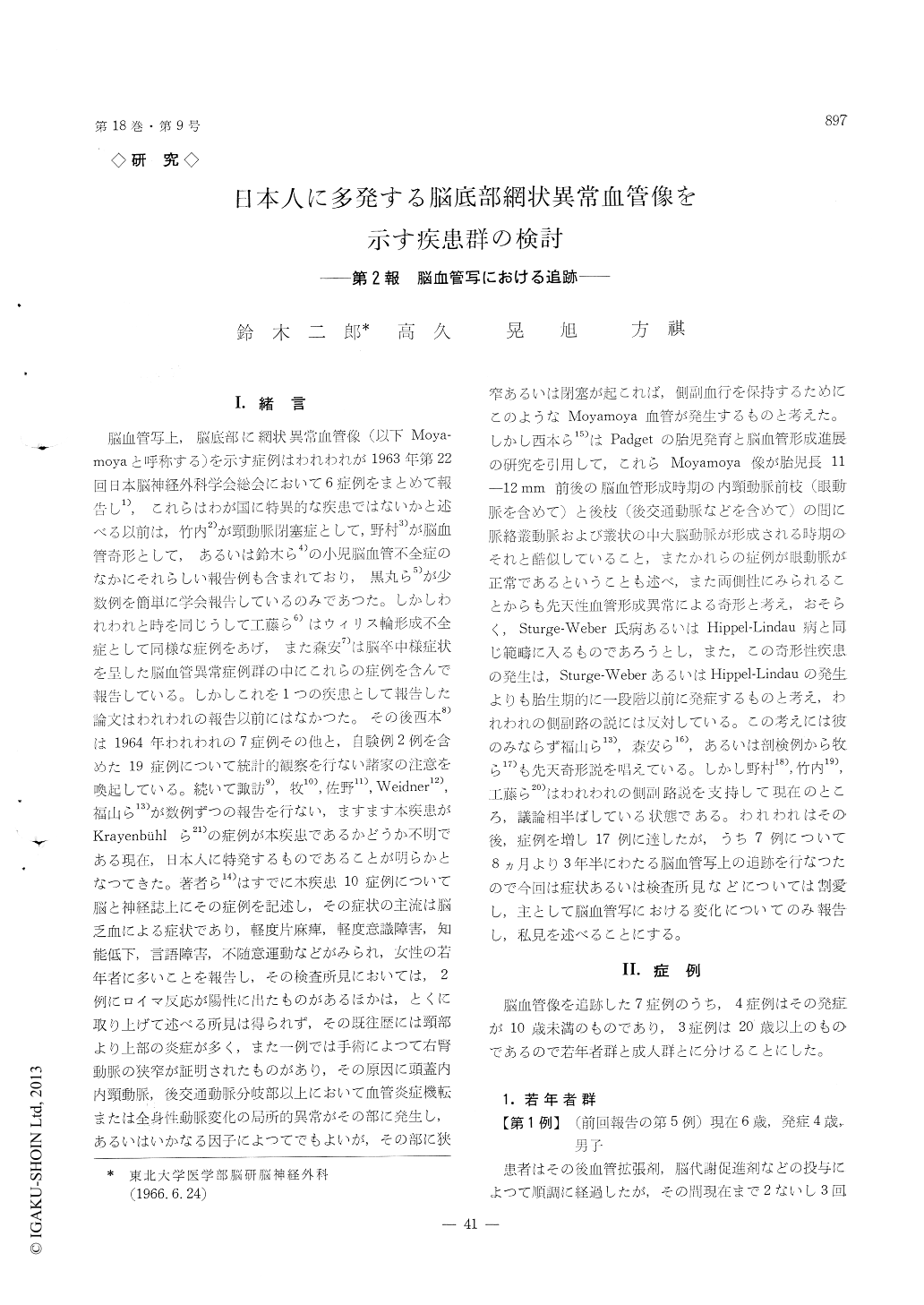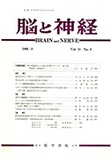Japanese
English
- 有料閲覧
- Abstract 文献概要
- 1ページ目 Look Inside
I.緒言
脳血管写上,脳底部に網状異常血管像(以下Moyamoyaと呼称する)を示す症例はわれわれが1963年第22回日本脳神経外科学会総会において6症例をまとめて報告し1),これらはわが国に特異的な疾患ではないかと述べる以前は,竹内2)が頸動脈閉塞症として,野村3)が脳血管奇形として,あるいは鈴木ら4)の小児脳血管不全症のなかにそれらしい報告例も含まれており,黒丸ら5)が少数例を簡単に学会報告しているのみであつた。しかしわれわれと時を同じうして工藤ら6)はウィリス輪形成不全症として同様な症例をあげ,また森安7)は脳卒中様症状を呈した脳血管異常症例群の中にこれらの症例を含んで報告している。しかしこれを1つの疾患として報告した論文はわれわれの報告以前にはなかつた。その後西本8)は1964年われわれの7症例その他と,自験例2例を含めた19症例について統計的観察を行ない諸家の注意を喚起している。続いて諏訪9),牧10),佐野11),Weidner12),福山ら13)が数例ずつの報告を行ない,ますます本疾患がKrayenbuhlら21)の症例が本疾患であるかどうか不明である現在,日本人に特発するものであることが明らかとなつてきた。著者ら14)はすでに本疾患10症例について脳と神経誌上にその症例を記述し,その症状の主流は脳乏血による症状であり,軽度片麻痺,軽度意識障害,知能低下,言語障害,不随意運動などがみられ,女性の若年者に多いことを報告し,その検査所見においては,2例にロイマ反応が陽性に出たものがあるほかは,とくに取り上げて述べる所見は得られず,その既往歴には頸部より上部の炎症が多く,また一例では手術によつて右腎動脈の狭窄が証明されたものがあり,その原因に頭蓋内内頸動脈,後交通動脈分岐部以上において血管炎症機転または全身性動脈変化の局所的異常がその部に発生し,あるいはいかなる因子によつてでもよいが,その部に狭窄あるいは閉塞が起これば,側副血行を保持するためにこのようなMoyamoya血管が発生するものと考えた。しかし西本ら15)はPadgetの胎児発育と脳血管形成進展の研究を引用して,これらMoyamoya像が胎児長11−12mm前後の脳血管形成時期の内頸動脈前枝(眼動脈を含めて)と後枝(後交通動脈などを含めて)の間に脈絡叢動脈および叢状の中大脳動脈が形成される時期のそれと酷似していること,またかれらの症例が眼動脈が正常であるということも述べ,また両側性にみられることからも先天性血管形成異常による奇形と考え,おそらく,Sturge-Weber氏病あるいはHippel-Lindau病と同じ範疇に入るものであろうとし,また,この奇形性疾患の発生は,Sturge-WeberあるいはHippel-Lindauの発生よりも胎生期的に一段階以前に発症するものと考え,われわれの側副路の説には反対している。この考えには彼のみならず福山ら13),森安ら16),あるいは剖検例から牧ら17)も先天奇形説を唱えている。しかし野村18),竹内19),工藤ら20)はわれわれの側副路説を支持して現在のところ,議論相半ばしている状態である。われわれはその後,症例を増し17例に達したが,うち7例について8ヵ月より3年半にわたる脳血管写上の追跡を行なつたので今回は症状あるいは検査所見などについては割愛し,主として脳血管写における変化についてのみ報告し,私見を述べることにする。
We reported 6 cases with angiographic abnormal vascular net-work in the basal region of the brain, and inferred that this disease might be found only in Japanese, at the 22nd Annual Meeting of the Japan Neurosurgical Society held in 1963. We also reported in details 10 cases with this disease in NO-to-Shinkei (Brain & Nerve), vol. 10, No. 8, 1965, and said that the disease is not a congenital malformation, but is a acquired disease in which at first stenosis or occlusion occurred in the terminal portion of the internal carotid artery due to some causes, and such abnormal vascular net-work has secondarily developed as collateral path-ways.
Seventeen cases of this disease were experienced at our clinic as to May, 1966, and among them 3 cases of the abult and 4 cases of the young were followed up angiographically for 8 months to 3 years and a half. In 3 cases of the adult there were seen no marked changes, however, on the other hand, in 4 cases of the young there were found noticeable chan-ges. From this fact we think that the adult cases may belong to quite another entity of diseases or these cases may represent the some phase at which the progress of disease has ceased, but can not tell which is correct at the present time.
The facts above described seem to be a proof of our thought which has been expressed from the very beginning of the discussion about this disease. We think the abnormal vascular net-work is not a congenital malformation, but is a vascular net-work formed secondarily as collateral path-ways due to stenosis or occlusion of the terminal portion of the internal carotid artery.
The net-works would develop on the both sides at last, although in appearing of the net-works there might be a chronological difference between the right and the left.
We have classified angiographically the develop-mental process of the abnormal vascular net-work into six phasis.
Here we would like to propose to give this peculiar abnormal vascular net-work a Japanese nomination, "Moya-moya", because the disease has been found only among Japanese. "Moya-moya" means in Japa-nese a state of clouds in the sky which have obscure shape, or smoke which comes out of the mouth on smoking especially by a deep expiration. Not only the vascular net-work simulates the smoke in shape, but also both have a similarity in the developmental pro-cess in which both appear thick at first, becoming thin gradually, and disappear at last. From the reason above given we call this disease cerbro-vascular "Mo-ya-moya".
1st phase : Stenosis of the bifurcation of int. carotid artery.
2nd phase : First appearance of "Moya-moya"(Dil-atation of the intracerebral arteries).
3rd phase : Increasing of "Moya-moya"(Dis-appearing process of middle and ant. cerebral arteries).
4th phase: Finer formation of "Moya-moya"(Dis-appearing process of posterior cerebral artery).
5th phase : Shrinking of "Moya-moya"(Dis-appearance of the intracerebral. arteries).
6th phase: Disappearance of "Moya-moya"(Pre-servation of cerebral circulation only through ext. carotid artery).

Copyright © 1966, Igaku-Shoin Ltd. All rights reserved.


